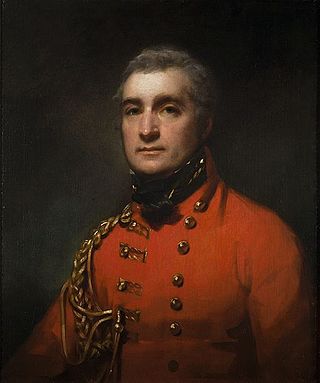William Crosbie | |
|---|---|
| Born | c.1740 |
| Died | 16 June 1798 |
| Allegiance | |
| Service/ | |
| Rank | Major general |
| Battles/wars | American Revolutionary War |
Major-General William Crosbie (c.1740 - 16 June 1798) was a British Army officer.
William Crosbie | |
|---|---|
| Born | c.1740 |
| Died | 16 June 1798 |
| Allegiance | |
| Service/ | |
| Rank | Major general |
| Battles/wars | American Revolutionary War |
Major-General William Crosbie (c.1740 - 16 June 1798) was a British Army officer.
Crosbie was commissioned as an ensign in the 38th Regiment of Foot in 1757. [1] He was promoted to lieutenant in 1759 and captain in 1769. [1] After serving at the evacuation of Boston in March 1776 during the American Revolutionary War, he was promoted to major in 1778. [2] Promoted to lieutenant colonel in 1781, he became commanding officer of the 22nd Regiment of Foot on promotion. [1] He raised the 89th Regiment of Foot in December 1793 [3] and was promoted to major-general in 1794. [1]
Crosbie also served as colonel of the 89th Regiment of Foot from 1793 to 1795 [3] and as colonel of the 22nd Regiment of Foot from 1795 to his death in 1798. [4] He was also Member of Parliament for Newark from 1790 to 1796. [1]
Lieutenant-General Robert Law was a British Army officer and colonial administrator for the colony of Newfoundland.

General James Stuart (1741–1815) was a British Army officer who served in North America during the American Revolutionary War and took part in various campaigns in British India. He was the first General Officer Commanding, Ceylon and second Military Governor of British Ceylon. He was appointed on 1 March 1796 and was Governor until 1 January 1797. He was succeeded by Welbore Ellis Doyle.
General Sir George Henry Frederick Berkeley KCB was a British Army officer and Conservative politician.

Lieutenant General Sir John Macdonald GCB was Adjutant-General to the Forces.

General Sir James Willoughby Gordon, 1st Baronet was a general officer in the British Army. He notably served as most long-standing Quartermaster-General to the Forces, holding the position for some 40 years.
Lieutenant-General James Montgomerie was a Scottish soldier and politician who sat in Parliament for Ayrshire 1818–29.
Lieutenant General Andrew Gordon was a British Army officer who became Lieutenant Governor of Jersey.

General Sir James Frederick Love was a British Army officer who served as Lieutenant Governor of Jersey.

General William Wemyss of Wemyss was a Scottish soldier in the British Army and Member of Parliament.
General Henry Renny (1815–1900) was a British Army officer who was the 24th General Officer Commanding, Ceylon.

General Henry Wynyard was a British Army officer who became Commander-in-Chief, Scotland.

Lieutenant-General Henry Keane Bloomfield was an English soldier and whilst serving in New South Wales an Australian politician.

General Sir James Vaughan Jackson, GCB, KH was an Irish officer in the British Army.
General the Hon. Edward Finch was a British Army general and a member of parliament.
General Charles Leigh was a British Army officer.
General James Marsh was a British Army officer.

General Gage John Hall was a British Army officer.
The 103rd Regiment of Foot (Volunteer Hunters) was a British Army regiment formed at Bury St Edmunds in October 1760. It took part, alongside the Royal Marines, in the Capture of Belle Île in April 1761 during the Seven Years' War. It was then disbanded in England in 1763.
General William Cartwright was a senior British Army officer.
General John Arthur Lambert was an English first-class cricketer and British Army officer.
{{cite web}}: CS1 maint: bot: original URL status unknown (link){{cite web}}: CS1 maint: bot: original URL status unknown (link)